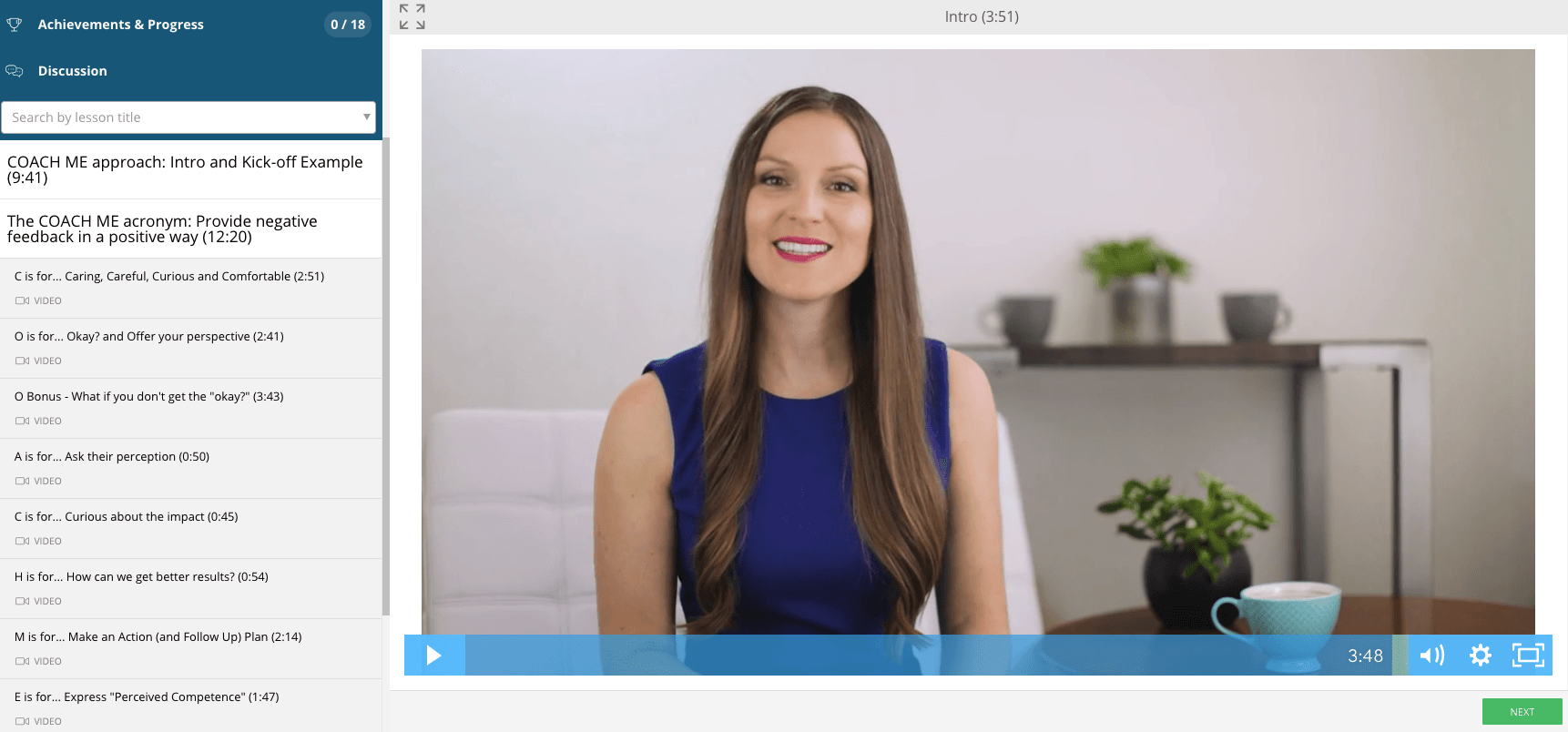SERIES: LEADERSHIP LEVEL FEEDBACK
BE A GREAT LEADER: GIVE EFFECTIVE PIVOTAL (NEGATIVE) FEEDBACK
HOW TO ‘COACH’ EMPLOYEES TO IMPROVE BEHAVIOR
April 10, 2017
It’s that twinge of discomfort you feel when you witness employee behavior that needs immediate pivotal feedback.
Hearing negative feedback triggers adrenaline, which makes us shut down (freeze), get defensive (fight) or disengage (flight). All of which create the opposite results of what we really need from an employee feedback session.
As a leader, you’re both the coach and the cheerleader (if you’re into sports metaphors).
The COACH ME model is your secret-sauce to providing pivotal (aka negative) feedback that keeps employees open, receptive and engaged.

Before we get started…
Did you know you can read this article or get my Udemy Course on How to Effectively Provide Negative Feedback to Employees?
Prefer to read instead of watch? Let’s dive in!
Caring, Careful and Comfortable
Caring: Approach with empathy and positive intent
Feedback should always leave the recipient inspired.
A caring, empathetic and supportive approach with help your employee be more open to hearing what you have to say.
Careful: Be thoughtful to not discourage behavior that is positive
Often, an employee’s intent is good, but would be more productive with different execution. Be careful not to discourage behavior that is positive but poorly executed.
For instance, interrupting with questions (you want them to stay curious and comfortable asking for clarification) or always having a reason why not to do something instead of providing solutions (at least #NegativeNancy is participating with critical thinking instead of being disengaged and apathetic).
Acknowledge the intent and importance of the behavior that is positive and productive before your next step of getting curious about the delivery.
Comfortable: Help them be receptive by being comfortable yourself
I’m always surprised when I hear someone say, “I’m just so uncomfortable with confrontation.” I’m surprised because it’s expressed as if it’s an uncommon problem. In fact, it’s a common sign of caring. Since you know confrontation makes you feel uncomfortable, you’re empathetic in expecting their discomfort. And who wants to be the bearer of bad news?
But it’s not bad news; it’s a gift! You know that person who never understands why they don’t get a promotion? Likely, there are 10 co-workers who have ideas as to why. It’s your responsibility to help your employees be the best they can be. They NEED your honesty and courage. Don’t let your mindset stop them from hearing feedback that could open up opportunities they want, but can’t get to without you.
Self-protection kicks in when we get confronted with anything resembling the classic “we need to talk” phrase. How do we know this is bad? The tone. The body language. The shifty eyes gravitating toward the floor.
If we want to maximize their receptiveness and our effectiveness, we must begin feeling comfortable and believing that this is a positive conversation to work toward the recognition, contribution and competence your employee needs to feel engaged and fulfilled at work.
The best way to start a potentially uncomfortable conversation is to the set the tone that you are comfortable enough to carry the conversation. If you lead with Caring and Careful, you’ll be off to a great start! Remember that you aren’t confronting, you are supporting for this person’s best interest – because you care. And because you’ve prepared for the conversation with the COACH ME process, you’ll feel more comfortable than if you just wing it or blurt it out after avoiding it for too long.
If you don’t get into a comfortable state and approach, you’ll communicate that the recipient has a reason to feel uncomfortable. It’s not about how you feel, it’s about supporting them, and to maximize their receptiveness, you have to find a way to get comfortable.
Keep your mindset that you are doing this because you care deeply about this other person and their success. How can you feel bad being of service?
Mindset Pep-Talk: If you think of feedback conversations as confrontation, it will be difficult to be comfortable. Change your inner dialogue to look at these conversations as gifts that could change the recipient’s life for the better. Resonate with how they need you to provide this feedback because it could unlock their dreams. Remember it’s because you care enough to tell them what other’s aren’t courageous enough to say.

Okay?
Always ask for permission to have the conversation (even if it’s rhetorical)
Keep your employees more comfortable by keeping them empowered.
By asking if it’s an okay time to check-in, you keep it on their terms and give them an opportunity to “opt-in” (building ownership and participation) or suggest another time if they need to cool down (or think or go to a meeting, etc.).
Example: It looked like you were frustrated in that meeting. Would now be an okay time to share what was on your mind?
Ask their perception (and Assert yours first if needed)
The more questions you ask the better. Especially when you ask about their experience.
Part one: Asking is a form of honoring, empowering, and respecting. Ask as much as you can and let your employees discover and problem solve, which enhances accountability, engagement and fulfillment.
Part two: Ask their perception. By asking for their perception, you honor their experience.
Use think/feel language (what do you think about… how do you feel about…). Asking what they think honors their competence. Asking what they feel humanizes the experience and creates connection. Since decisions are mostly made from our perception lens and/or emotions, we get more honest answers by connecting with this approach.
Additionally, you can’t argue with someone’s perception of something, so they can express their experience without judgment or ridicule. It also leaves room for other perceptions, experiences and possibilities, leading the way for a productive and open conversation about alternate approaches.
Part three: If your feedback is unplanned/in-the-moment, you’ll likely have to assert your perception first to open up the conversation and set the context. Just be careful to keep your perception as light as possible to leave room to hear there’s (more important).
Your perception only sets the context, theirs provides the content of the conversation.
Example: It seemed like you were frustrated in that meeting. Is now an okay time to share what’s on your mind? [yes] What did you think about the interaction between you and Jane?
Example: How do you feel the project is going? (A perfect opener even if you already know something is off course)

Curious about the impact
Inspire their curiosity about how their decisions/actions impact co-workers/customers.
If you want to create accountability, engagement and empowerment, let your employee be the one to think of a better approach/solution.
This means you have to stay curious asking questions (not make suggestions/statements).
Hopefully, after the above COA strategies, your feedback recipient is still open and curious.
Humans are driven to be competent, praised and accepted. Often you’ll find employees already know they could have done something different, but they’ll only feel comfortable sharing that with you if you create a safe environment.
If they aren’t open or don’t see a problem with the behavior (which is hopefully rare), you can make a suggestion, but word it as a question.
Example: “Do you think there is a different approach you can use to get [desired result]?”
Last resort example: “Do you think [this approach] would help [get this result better]?”

How get better results?
Ask them what could be done differently to get a better result.
If you want to create accountability, engagement and empowerment, let your employee be the one to think of a better approach/solution.
This means you have to stay curious asking questions (not make suggestions/statements).
Hopefully, after the above strategies, your feedback recipient is still open and curious.
Humans are driven to be competent, praised and accepted. Often you’ll find employees already know they could have done something different, but they’ll only feel comfortable sharing that with you if you create a safe environment.
If they aren’t open or don’t see a problem with the behavior (which is hopefully rare), you can make a suggestion, but word it as a question.
Example: “Do you think there is a different approach you can use to get [desired result]?”
Last resort example: “Do you think [this approach] would help [get this result better]?”
Make the action plan
Create an action and followup plan
Your only goal here is to support them in getting results for themselves.
Yes, it benefits you/the company/co-workers, too. But stay in a place of supporting them so they feel comfortable keeping you as a partner in their success instead of seeing you (and future conversations) as a threat.
Example: What can be done to work on [discussed approach]? When can we follow up to see how that’s going?
Express perceived competence
Create an action plan and followup conversation
Perceived competence is a powerful tool to get better performance, engagement and morale from your employees.
Always end the feedback session with perceived competence.
Example: I know you can do this.
Example: You’re the best person for this job, and I know you can [do this better/work on this/show up like this].
—
Let the COACH ME model help you make giving pivotal feedback more comfortable, positive and productive!
Q: When would you have appreciated this approach when someone’s given you feedback? How could you use this approach in providing feedback with a current employee challenge? Share your comments below so other leaders can learn from your experience!

And lastly…
Use think/feel language
It builds competence/humanizes
Everything is subjective to our filter, perspective, thoughts and feelings about what we experience.
By asking “what do you think [about this]” and “what do you feel [about this],” you’ll lead a more productive conversation that helps you understand and address where they’re at and that keeps employees “Curious about the impact” without making them wrong, which triggers self-protection.
It allows them to have their own experience and for others to have a different one, allowing curiosity, conversation and exploration.
Instead of: Did it go well? / Are we making the right decision?
Ask: Did you think it went well? / Do you feel this is the right decision? (Then you can say, “I thought/I feel [this different viewpoint]”)
This tool might seem like subtle semantics, but it’s an incredibly powerful choice that increases employee engagement, innovation and morale.
—
Let the COACH ME model help you make giving pivotal feedback more comfortable, positive and productive!
Q: When would you have appreciated this approach when someone’s given you feedback? How could you use this approach in providing feedback with a current employee challenge? Share your comments below so other leaders can learn from your experience!

